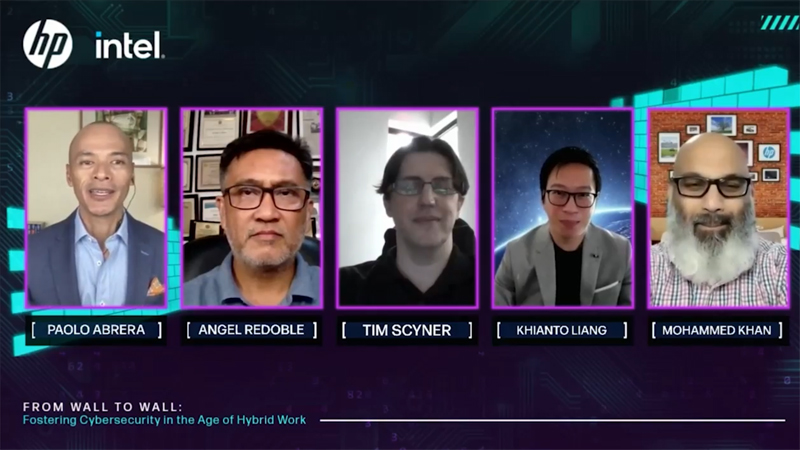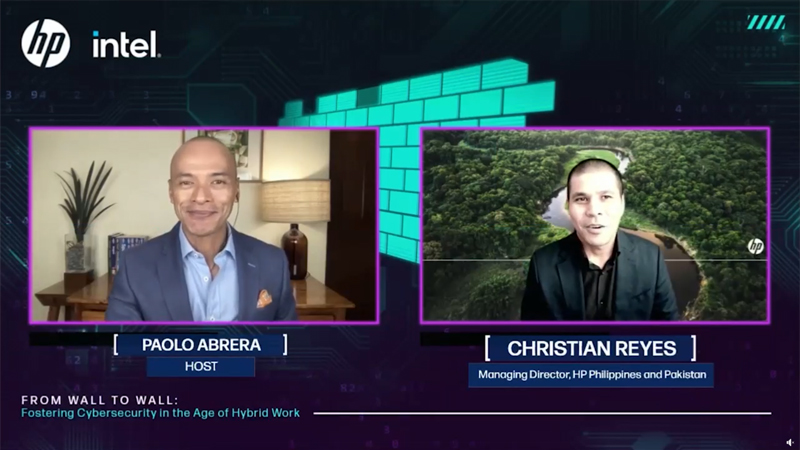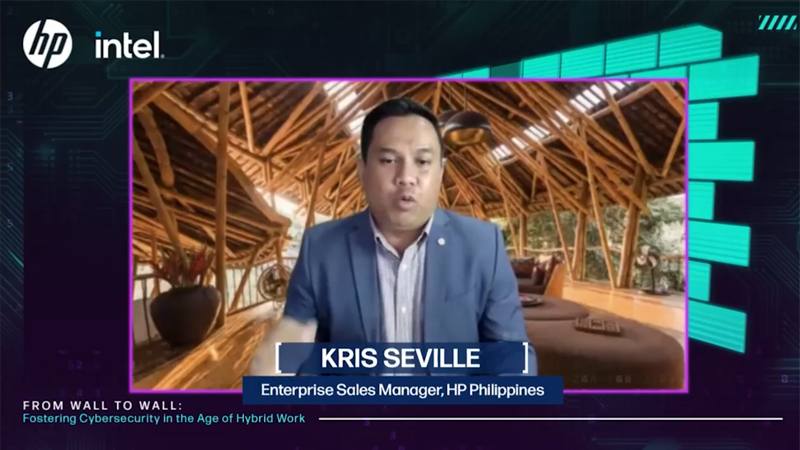Getting hacked is not a matter of “if’ but of “when”, as the well-known cybersecurity mantra puts it.
We should all be prepared for a perpetual defensive war against unseen opponents.
This mindset is especially challenging in the business process outsourcing (BPO) industry, which is one of the best-performing and employment generating activities in the past four years. To help local cybersecurity executives address these issues, HP and Intel Corporation recently held a webinar titled “From Wall to Wall: Fostering Cybersecurity in the Age of Hybrid Work”.
The webinar’s objective was simple: convince company leaders to welcome the challenge of forging a long-term remote work strategy as many workplaces, due in large part to the ongoing Covid-19 pandemic, adopt a hybrid setup where many of its employees work from home. This has spawned a world-wide scenario where work devices have become vulnerable to cyberattacks outside the protection of the corporate network.
“We’re good”
“The common misconception is that ‘I have an antivirus and I have a firewall, and we’re good.’ But in a previous webinar, also organized by HP and Intel, Christian Edmond Reyes, Managing Director of HP Philippines and Pakistan, warned that due an era of a dispersed workforce “the threats and the risks of vulnerability are much higher.”
The webinar held last March – “Forging a Safety (Inter) Net for the Agents”— pointed to statistics from the Philippines’ National Bureau of Investigation (NBI) Cybercrime division, showing a 200% increase in phishing attacks last year. It likewise cited Russian cybersecurity provider Kaspersky’s findings which that the country has, for two straight years, topped the list in Southeast Asia in terms of internet-based threats.
“One of the points of vulnerability is usually the employee and that’s where education is important and primarily because sometimes you can just receive an innocuous email with a seemingly harmless link. You click it and it wreaks havoc,” Reyes said. “HP wants to be able to help our partners to be more secure, prevent any disruption, prevent any cyberattacks that can cause damage to your reputation, your productivity and has financial repercussions.”
Ensuring BPO security at home, amid RTO mandate
Data from 2019 showed that an estimated 1.3 million Filipinos work in BPO companies, making it a significant contributor to the country’s GDP. The IT & Business Process Association of the Philippines (IBPAP) expects that the industry will grow by 5.5% within the next two years.
With the current health and safety restrictions in place, the association figured that an average of 70% of the workforce is still working from home.
For employers, among the trickiest to master when it comes to implementing the hybrid work setup is cybersecurity. This is partly due to the fact that the country is consistently hit by various and ever-evolving cyber threats ranging from web attacks, remote desktop protocol (RDP) attacks, and even mobile malware. This situation calls on all hybrid employees, not just IT professionals, to take up responsibility in fighting off malicious attacks.
Figuring out a viable “back to work transition
Cyber security risks are among the reasons why BPO firms were not too enthusiastic about the government’s recent return-to-office mandate. Announced last March, BPOs were supposed to halt their work-from-home arrangements with employees and require them to immediately report for on-site work by April 1, or lose their tax perks. But from a cybersecurity perspective, the resulting disruptive impact would be akin to self-induced sabotage.
To ensure network security in an RTO scenario, each company’s IT team needs ample time to figure out and put in place a viable “back to work” transition plan. The challenging task involves includes running endpoint detection scans on all returning devices that did not utilize standard corporate cybersecurity software protection during remote work.
“These devices are often the focus of hackers,” a cybersecurity consultant pointed out. “Properly scanning them all and updating their security patches would take time, especially for a small IT team.”
Empowering the end-user
Data from Kaspersky in the last five years show that end-users globally are facing an increasing number of web threats. For the first half of 2022, about 14 million of these end-point threats were detected in the Philippines. This coincides with the rise of hybrid work being implemented by many employers in the country. It also emphasizes the need for wall-to-wall kind of IT security that begins with well-trained and responsible end-users.
“When you’re working from home, every asset that you use to connect to the company network and do your work, including your personal smart devices, they all become potential entry points of attack,” said Angel Redoble, First Vice President and Chief Information Security Officer for PLDT Group. “As a responsible employee, you need to declare them to the cybersecurity team, so they can properly secure them as vital assets. In a BPO, however, the agents themselves are the most important assets and you need to empower them with adequate training.”
Redoble added that employers should conduct a continuing end-user training program and not the usual one-off awareness seminars. To keep them vigilant and abreast of latest threats, agents should be subjected to phishing simulation drills both impromptu and pre-announced. This way the company can monitor their readiness as well as their need for supplemental training.
Beyond providing training, employers should also make it a point that employees understand that the benefits of working from anywhere comes with added and serious responsibilities.
“If your employee is aware that the end-point is their responsibility, and part of their duty to flag you immediately whenever they encounter something unusual or weird, that would go a long way to improving your company’s resilience to cyberattacks,” said Tim Scyner, Director of Sitel Group Physical Security.
Aside from dodging pesky phishing emails, Scyner said employee vigilance can also help the IT security team detect potential malware attacks and costly data breaches. Empowering them with secure hardware and infrastructure, however, should remain to be top priority from the point of view of the cybersecurity team.
Investing in powerful software, hardware security
A security solution that experts find most fitting for a hybrid workforce is the HP Wolf Security. In the webinar, HP consultant Mohammed Khan said the security platform offers a robust endpoint protection built-in to HP PCs and printers, featuring multi-layered security deployed below, in, and above the operating system.
One key capability of the HP Wolf Security is how it contains threats using micro-virtualization. With it, Khan said HP forms a virtual air gap between the application and the host PC, thus fully isolating the device’s operating system and protecting it from malicious actors.
With today’s advanced sophistication of hackers, however, PC protection should not be confined to software security but must also be rooted in the hardware itself. For this, Intel’s vPro platform offers enhanced security via hardware-based protection against firmware attacks.
“Intel’s vPro platform offers a built-in, system-level security that starts in hardware, and improves foundational security, data and workload protection. The platform also includes capabilities for remote access, to allow IT administrators to install security patches and repair PCs,” said Khianto Liang, SEA & Korea Regional Manager for Intel Corporation.
Cybersecurity tips
At the latest webinar (“From Wall to Wall….”), both Redoble and Scyner traded priceless insights and defense tactics that webinar attended found useful, especially in the hybrid work scenarios.
“Implementing a holistic or wall-to-wall cybersecurity program involves building and enhancing your predictive, preventive, detective, and responsive capabilities,” said Redoble. “Underlying them all is visibility, or knowing exactly what your systems and assets are, and from there understanding your threat landscape. You cannot possibly defend them if you are not sure what they are and what their vulnerabilities are.”
“Sooner or later a determined hacker will eventually get into your system,” Scyner declared. “In preparation, what you can do is delay them from causing any trouble. Build a maze with as many obstacles and dead ends as possible. Just delay the hack long enough for your team to detect it and shut it down.”
Capping the informative discussions, webinar organizer HP Philippines assured cybersecurity professionals in the BPO industry that it will continue to work with its partners to ensure robust, wall to wall cybersecurity is in place to deter all malicious actors.
“HP is aware of the very real challenges that BPO companies have been having, transiting from the work-from-home setup and into the hybrid workspace,” said Kris Seville, Enterprise Sales Manager of HP Philippines. “We would very much love to hear from you, so that together we can explore how HP Philippines can help address your specific situation.”
To watch the full webinar, a recorded version is available via this link: https://www.facebook.com/HPphilippines/videos/458925112532945
Liked this post? Follow SwirlingOverCoffee on Facebook, YouTube, and Instagram.




